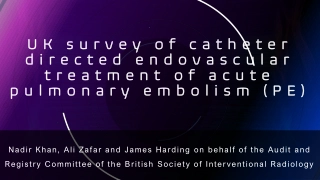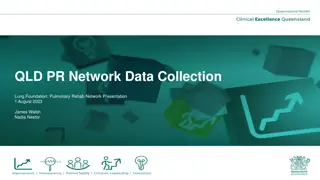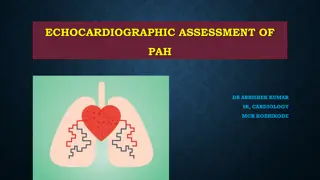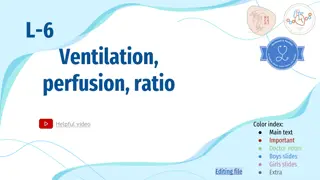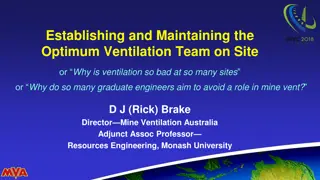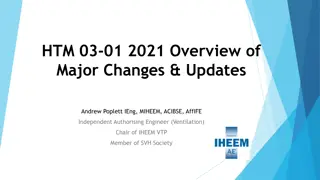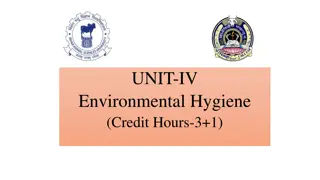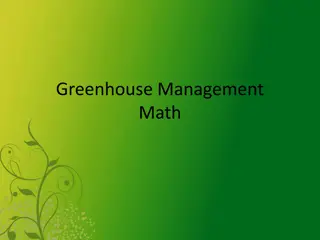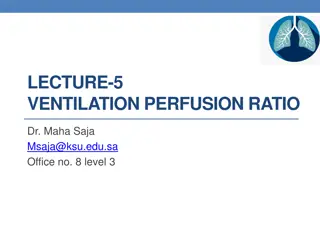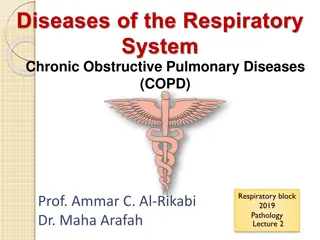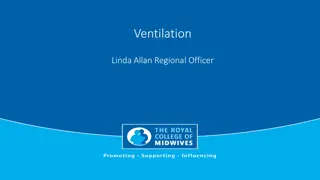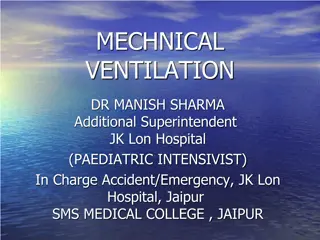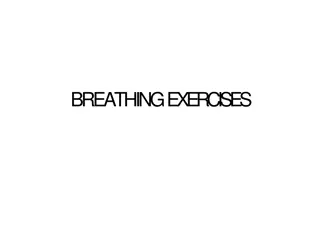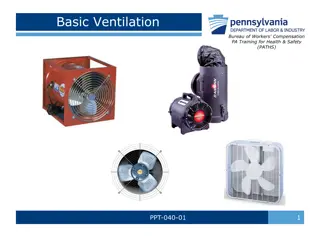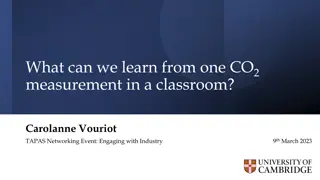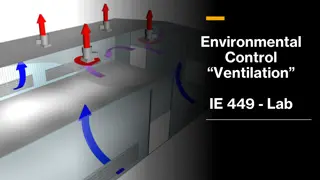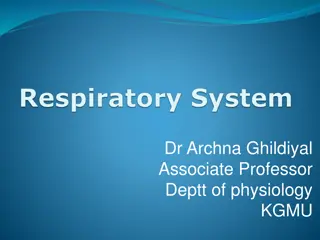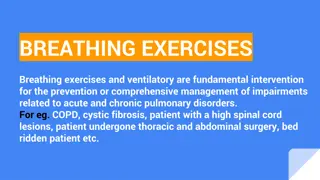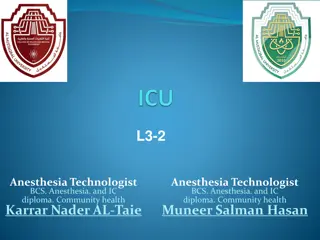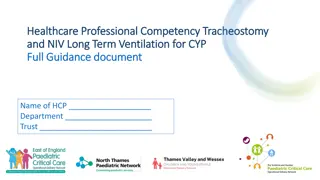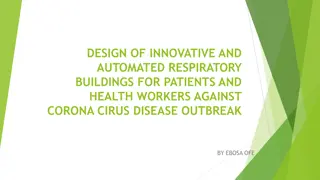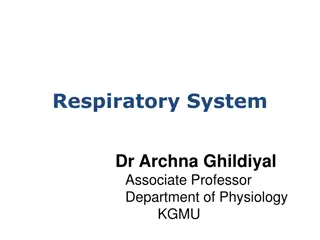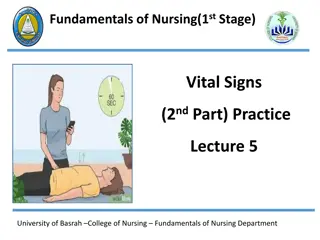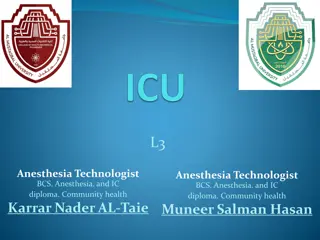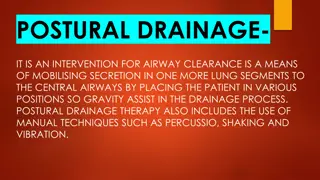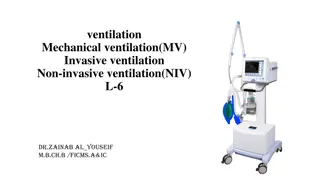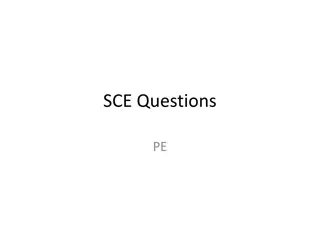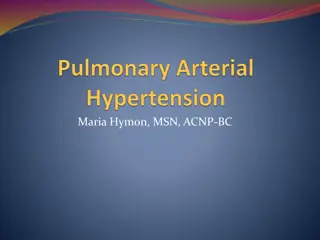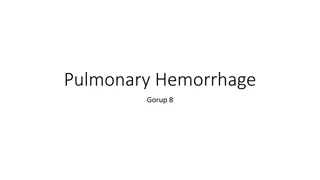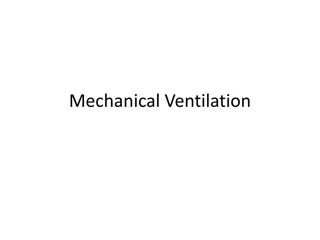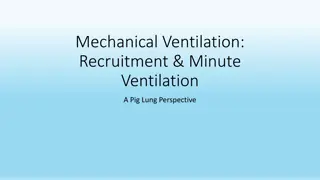UK Survey on Endovascular Treatment of Acute Pulmonary Embolism
Acute pulmonary embolism (PE) is a significant issue in hospitalized patients, with current treatments focusing on anticoagulation and systemic thrombolysis. Surgical treatments have shown poor outcomes, leading to a rise in endovascular techniques aimed at reducing clot burden. A survey conducted i
0 views • 12 slides
Pulmonary and Critical Care Lecture Highlights: Bronchiectasis and Sarcoidosis Overview
Dive into the realm of pulmonary and critical care as Dr. Michael Forte discusses the intricacies of bronchiectasis and sarcoidosis. Understand the etiologies, diagnosis, investigations, and treatment options for these respiratory conditions. Explore the challenges and nuances of managing patients w
0 views • 35 slides
Functions of the Respiratory System and Ventilation Mechanism
The respiratory system performs crucial functions such as ventilation to facilitate gas exchange, maintaining pH balance, and enabling vocal sounds. It consists of the upper and lower respiratory systems, including structures like the nose, trachea, bronchi, and alveoli. The system's epithelium, the
7 views • 43 slides
Radiographic Imaging Methods of the Respiratory System
Radiographic imaging plays a crucial role in the evaluation and diagnosis of thoraco-mediastino-pleuro-pulmonary conditions. Techniques like radioscopy, digital radiography, computer tomography, magnetic resonance imaging, conventional pulmonary angiography, and hybrid imaging methods offer detailed
10 views • 21 slides
Statewide Pulmonary Rehabilitation Project Overview
The Statewide Pulmonary Rehabilitation Project, funded by Clinical Excellence Queensland, aims to enhance care models for chronic lung diseases like COPD and asthma. The project explores virtual rehabilitation integration, ensuring equity and improved access for patients. Challenges include resource
4 views • 21 slides
Echocardiographic Assessment of Pulmonary Arterial Hypertension (PAH) Overview
Echocardiographic assessment plays a crucial role in the diagnosis, management, and prognostic evaluation of pulmonary arterial hypertension (PAH). This condition is characterized by elevated mean pulmonary arterial pressure and pulmonary vascular resistance, leading to various clinical features suc
6 views • 43 slides
Understanding Pulmonary Circulation and V/Q Ratio in Respiratory Physiology
Explore the high-pressure and low-pressure circulations supplying the lungs, the concept of physiological shunt in pulmonary circulation, different lung zones based on blood flow, V/Q ratio and its clinical significance, and abnormal V/Q ratio patterns. Delve into the role of pulmonary circulations
11 views • 28 slides
Overview of Mechanical Ventilation in Critical Care
Discussing the indication, modes, variables, and controls of mechanical ventilation as well as the differences between volume and pressure control. Exploring assist control, synchronized intermittent mandatory ventilation, and other key aspects of ventilator management by Dr. Zia Arshad.
0 views • 22 slides
Enhancing Mine Ventilation for Optimal Performance
Discover the key role of ventilation in mining operations, debunking misconceptions about its importance. Learn how good ventilation practices contribute value to a mine, improve safety, reduce costs, and boost productivity. Explore the crucial considerations in establishing and maintaining an effic
0 views • 26 slides
Overview of HTM 03-01-2021 Major Changes & Updates in Healthcare Ventilation Systems
This overview covers the major changes and updates in healthcare ventilation systems as per HTM 03-01-2021. It emphasizes the shift towards net-zero carbon emissions by 2050, promoting sustainable ventilation practices. Key aspects include the role of Ventilation Safety Groups, derogation processes,
0 views • 21 slides
Proper Ventilation for Animal Houses: Importance and Guidelines
Ventilation in animal houses is crucial for removing stale air and replacing it with fresh air to maintain optimal conditions for animals and their attendants. Improper ventilation can lead to various issues like high humidity, disease spread, and vulnerability to pathogens. This article discusses t
0 views • 12 slides
Understanding Pulmonary Circulation and Its Importance in Respiratory Physiology
Pulmonary circulation, as explained by Professor Narsingh Verma, plays a crucial role in the respiratory system, showcasing distinct differences from systemic circulation. The low pressure and resistance in pulmonary circulation allow for optimal gas exchange at the alveolocapillary membrane. Variou
1 views • 30 slides
Greenhouse Management and Temperature Control Guide
Learn about the importance of ventilation and temperature control in greenhouse management, including how to calculate required ventilation and heater size. Understand the benefits of proper ventilation, ways to control greenhouse temperature, and essential considerations for heating. Explore step-b
1 views • 21 slides
Comprehensive Overview of Pulmonary Function Tests (PFTs)
Pulmonary Function Tests (PFTs) are vital for assessing pulmonary gas exchange through ventilation, diffusion, and lung perfusion. These tests include measurements of lung volume, airway patency, gas exchange efficacy, and pulmonary blood flow. PFTs offer benefits in diagnosing dyspnea, monitoring d
0 views • 14 slides
Understanding Ventilation-Perfusion Ratio in Pulmonary Circulation
This lecture delves into the intricate relationship between ventilation and perfusion in the lungs, highlighting the importance of proper gas exchange for optimal respiratory function. It discusses the circulations supplying the lungs, defines the V/Q ratio, and explores the clinical significance of
0 views • 25 slides
Understanding Chronic Obstructive Pulmonary Diseases (COPD) and Emphysema
Chronic Obstructive Pulmonary Diseases (COPD) encompass conditions like chronic bronchitis and emphysema, typically caused by factors like cigarette smoking. This presentation delves into the clinical and functional variances between chronic bronchitis and emphysema in COPD patients, along with an e
1 views • 40 slides
Importance of Ventilation in the Workplace Environment
Adequate ventilation plays a crucial role in reducing the risk of virus transmission, particularly aerosols, in enclosed areas like workplaces. This presentation highlights the significance of ventilation and how health and safety representatives can collaborate to address concerns. It also discusse
0 views • 20 slides
Understanding Mechanical Ventilation in Critical Care Environments
Mechanical ventilation, overseen by Dr. Manish Sharma, Pediatric Intensivist at JK Lon Hospital, Jaipur, is essential for treating respiratory failure. It involves using ventilators to deliver gas to the lungs and meet specific goals like correcting hypoxemia and hypercapnia. This process requires u
0 views • 55 slides
Understanding the Importance of Breathing Exercises in Respiratory Management
Breathing exercises, also known as ventilatory training, play a crucial role in improving pulmonary status, enhancing endurance, and increasing overall functionality in daily activities. These exercises help retrain respiratory muscles, improve ventilation, reduce breathing effort, enhance gas excha
0 views • 32 slides
Basic Ventilation Training for Health & Safety
This training presentation covers the basic concepts of ventilation, including reasons for ventilation, proper techniques, student objectives, types of ventilation, methods of ventilation, and ventilation safety precautions. Ventilation is crucial for maintaining high-quality indoor air, removing un
5 views • 22 slides
Insights from CO2 Measurement in Classroom Ventilation
Understand the significance of CO2 measurements in classroom ventilation for better indoor air quality and reduced infection risks. Explore the use of CO2 sensors, data analysis, and proxy models to improve ventilation systems in schools. Discover findings on airborne infection risk and variations w
2 views • 9 slides
Pulmonary Hydrotherapy: Innovation in Exercise for COPD Patients
Pulmonary hydrotherapy is being explored as a safe and effective form of exercise for COPD patients, challenging previous beliefs about water-based activities. South Tees Pulmonary Rehabilitation Service is examining the benefits of hydrotherapy in improving exercise capacity and quality of life, ba
1 views • 10 slides
Understanding Industrial Ventilation Systems for Workplace Safety
Ventilation plays a crucial role in maintaining a safe working environment by providing fresh air, controlling contaminants, and reducing health risks for workers. This article covers the importance of ventilation, areas at risk of deficiency, components of industrial systems, types of ventilation s
0 views • 18 slides
Mechanics of Pulmonary Ventilation and Respiratory Cycle Explained
Understanding the mechanics of pulmonary ventilation is crucial for comprehending the breathing process. This comprehensive overview covers the role of muscles, ribs, pressure changes in alveolar, pleural, and transpulmonary regions, terms related to breathing and ventilation, and the contraction an
0 views • 31 slides
Breathing Exercises for Pulmonary Health
Breathing exercises are essential interventions for managing pulmonary disorders like COPD, cystic fibrosis, and post-operative complications. They help improve ventilation, cough effectiveness, muscle strength, and reduce stress. Different types of exercises like diaphragmatic breathing and pursed
0 views • 13 slides
Understanding Mechanical Ventilation in Anesthesia Practice
Anesthesia technologists play a crucial role in managing artificial ventilation, including concepts like Invasive Positive Mechanical Ventilation (IPMV), Fraction of Inspired Oxygen (FIO2), Tidal Volume (VT), Peak Flow Rate, Respiratory Rate, Minute Volume (VE), I:E Ratio, and more. They monitor and
0 views • 27 slides
Healthcare Professional Competency: Tracheostomy and Long-Term Ventilation for Children and Young People
This document provides guidance for healthcare professionals caring for children and young people requiring tracheostomy and long-term ventilation. Developed by experts in pediatric care, the competencies cover essential skills and knowledge necessary for safe and effective patient care outside tert
0 views • 16 slides
Innovative Automated Respiratory Buildings for Corona Virus Outbreak
Ebosa Ofe presents a pioneering design of automated respiratory buildings aimed at safeguarding patients and health workers against the Corona virus outbreak. The buildings utilize advanced ventilation systems to ensure a safe and healthy environment, combating the spread of COVID-19. Explore the co
0 views • 12 slides
Understanding Respiratory System: Lectures on Alveoli Stability, Compliance, and More
Dive into the complexities of the respiratory system with these enlightening lectures covering topics such as the stability of alveoli, lung compliance, airway resistance, surface tension, and the interdependence of alveoli. Gain insights into the factors affecting pulmonary ventilation and learn ab
0 views • 32 slides
Understanding Respiratory Rate and Ventilation in Nursing Practice
This lecture focuses on the vital signs related to respiratory rate, emphasizing the three processes of respiration: ventilation, diffusion, and perfusion. Nurses assess ventilation by observing the rate, depth, and rhythm of respiratory movement, crucial in recognizing normal thoracic and abdominal
0 views • 51 slides
Understanding Mechanical Ventilation in Anesthesia Technology
Mechanical ventilation plays a crucial role in assisting patients with breathing difficulties by delivering oxygen and removing carbon dioxide. It involves two primary types: Negative Pressure Ventilation (NPV) and Positive Pressure Ventilation (PPV). NPV helps patients with conditions like chronic
0 views • 19 slides
Postural Drainage Therapy for Airway Clearance
Postural drainage therapy is an intervention used for airway clearance by mobilizing secretions in specific lung segments towards the central airways. It involves placing the patient in various positions to facilitate gravity-assisted drainage. The therapy includes manual techniques such as percussi
0 views • 13 slides
Ventilation in Critical Care: Basics and Calculations
Understanding mechanical ventilation is crucial in managing critically ill patients. This content covers concepts like I:E ratio, total cycle time calculation, inspiratory and expiratory times, and practical examples. Learn how to adjust ventilator settings based on patient parameters and conditions
0 views • 11 slides
Understanding Haemodynamic Consequences of Acute Pulmonary Embolism
Haemodynamic consequences of acute pulmonary embolism (PE) include increased mean pulmonary artery pressure, rise in right ventricular preload and end-diastolic pressure, risk of right ventricular failure, and decreased pulmonary blood flow leading to low systolic blood pressure. Arterial hypoxia ca
0 views • 18 slides
Understanding Pulmonary Arterial Hypertension (PAH): Causes, Symptoms, and Management
Pulmonary Arterial Hypertension (PAH) is a progressive disease characterized by increased blood pressure in the pulmonary artery, veins, or capillaries. This condition can lead to right ventricular failure and eventual death if left untreated. PAH can have various causes, including idiopathic factor
0 views • 49 slides
Overview of Pulmonary Hemorrhage in Infants
Pulmonary hemorrhage in infants is a severe condition characterized by bloody discharge from the upper respiratory tract or endotracheal tube, often associated with prematurity, lung complications, infections, or trauma. The etiology, pathophysiology, clinical manifestations, and diagnosis of pulmon
0 views • 14 slides
Understanding Mechanical Ventilation in COPD Exacerbation
In a case of a 64-year-old woman with COPD exacerbation, managing respiratory distress is crucial. Initiating systemic corticosteroids, doxycycline, and nebulizers while closely monitoring the patient is important. However, in cases where non-invasive ventilation is ineffective, the patient may requ
0 views • 22 slides
Understanding Mechanical Ventilation in a Pig Lung Perspective
Explore recruitment strategies, minute ventilation concepts, and optimization techniques in mechanical ventilation from a unique pig lung perspective. Learn about benefits, recommended PEEP levels, driving pressure, goals of ventilation, and the concept of permissive hypercapnia in respiratory care.
0 views • 14 slides
Temporary Ventilation Project Overview and Challenges
The FE Minute provides an overview of a temporary ventilation project managed by Elisabete Godden, aiming to enhance air flow in classrooms without mechanical ventilation to combat the COVID pandemic. The project involves installing ventilation systems at various spaces within 20 days with a budget
0 views • 14 slides
Design Strategies for Buildings in the UK: A Literature Review
The literature review explores design strategies for buildings in the UK, focusing on ventilation systems, building regulations, and approved document guidelines. Various ventilation systems are discussed, including background ventilators, passive stack ventilation, and mechanical ventilation with h
0 views • 11 slides
